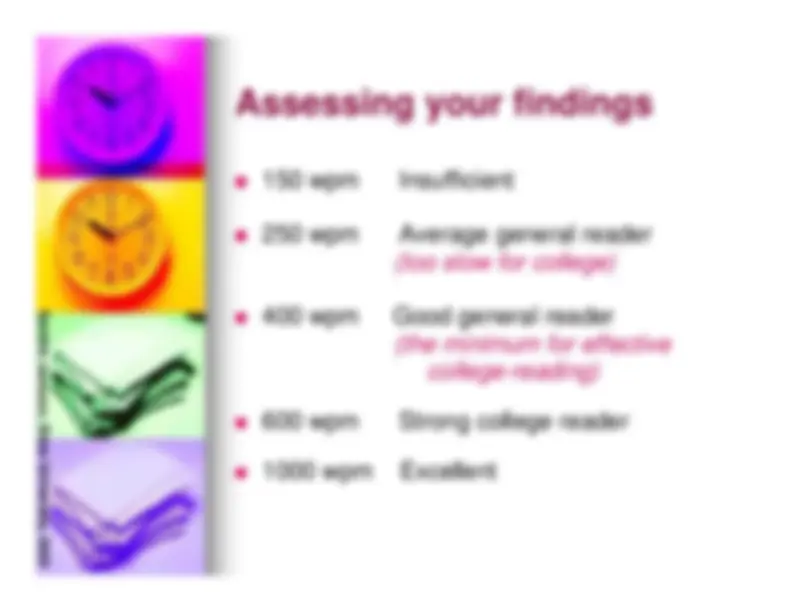













Study with the several resources on Docsity

Earn points by helping other students or get them with a premium plan


Prepare for your exams
Study with the several resources on Docsity

Earn points to download
Earn points by helping other students or get them with a premium plan
Community
Ask the community for help and clear up your study doubts
Discover the best universities in your country according to Docsity users
Free resources
Download our free guides on studying techniques, anxiety management strategies, and thesis advice from Docsity tutors
Insights from Sandra Jamieson's Drew University publication on how to read faster and more effectively for college students. It includes instructions on testing reading speed, causes of slower reading, strategies for effective reading, and tricks for successful reading.
What you will learn
Typology: Study notes
1 / 19

This page cannot be seen from the preview
Don't miss anything!












Sandra Jamieson, Drew University, 2005
... It is about learning to read
as
effectively
as you can
Count the number of words in ten lines and writethat down;
now divide that number by 10. That is the averagenumber of words per line. Write it down;
now count the number of lines you read andwrite it on a piece of paper. Write it down;
multiply that number by the number of words per line,and you have roughly how many words you read.Write down the number you get
You read for ten minutes. Divide the total numbersof words you read by 10 and you have your words-per-minute.
Write it down.
Assessing your findings
So now what?
There are three main factors involved inimproving reading speed:
(1) the desire to improve,(2) the willingness to try new techniques, and(3) the motivation to practice.
Most people can double their reading speedwhile still maintaining equal or even highercomprehension.
Warning: In order to learn to read rapidly and well you musthave acquired the necessary vocabulary.
When you can understand college-level materials,you are ready to practice reading faster.
The average college student reads about 350 words perminute. A "good" reading speed is around 500 to 700words per minute, but some people can read a thousandwords per minute.
What makes the difference?
Strategies for effective reading
Pre-Read
: Skim the piece looking for sub-headings,
images, graphs etc. Try to get a sense of what thereading is about.
You can call this READING FOR PLOT (like reading the end of a mystery novel before you get there);
Pre-think
: ask yourself some questions that this
reading might answer, things on the syllabusperhaps, or from the lecture. Think BEFORE youread.
You can call this CREATIVE THINKING;
Read in blocks
: Read several words at once (a
phrase, half a line, or a full line in textbooks withcolumns);
Pause ONLY at the end of sections. Don’t reread,but jot down what you remember at the end of eachsection. You can go back and reread at the end.Don’t wait for the action replay. Just read!
A Trip Down Memory Lane
Before that you sounded letters
.
R - E - M - E - M - B - E - R
okay
RE - MEM - BER
Tricks for successful reading
Reading one word at a time in college is likesounding out letters or parts of words
It TAKES TOO LONG
Instead...
Read in blocks
: Read several words
at once (a phrase, half a line, or a fullline in textbooks with columns);
We are going to practice this
Tricks for successful reading
We are going to practice this
Using the eye-guide
Move the eye-guide downthe page as you read.
One line at a time.
Focus on the dot, and justsee the words
Article source
:
www.sedl.org/reading/topics/brainreading.pdf.
Now YOU need to practice…The Basic Program:
Two or three times a day
, read something you enjoy for
15 to 20 minutes without stopping. Time yourself to within30 seconds.
Record your reading rate
and chart your progress.
Recording and charting are essential if you wish to makereal progress.
Push yourself gently
as you read. If your mind wanders,
get it back on track.
Set reading-rate goals
for yourself. Aim for a 10%
increase in your reading rate over the previous record.
Practice skimming & scanning
by finding an interesting
newspaper column or magazine article and rapidlyreading the article, sampling just the first sentence or twoof each paragraph and a few key words. Jot down all thefacts you can remember. Then reread the article slowly,giving yourself a point for every item you can recall.
READ YOUR TEXBOOKS ACTIVELY!
REVIEW:TO ACTIVE READ YOU:
Ask general beginning questions;
Set a purpose by pre-viewing achapter, and deciding what you hopeto learn;
Guide yourself through the reading byskimming first, looking at its length,sub-headings (
the plot
), images,
charts and graphs, etc.;
Make notes, highlight, and summarizeAFTER
the reading is done!
AND BECOME MORE EFFECTIVE!!!
Okay, let’s try this
Put a mark next to the line whereyou stopped.
Did you read more than the firsttime?
Now PRACTICE
Good luck!!!